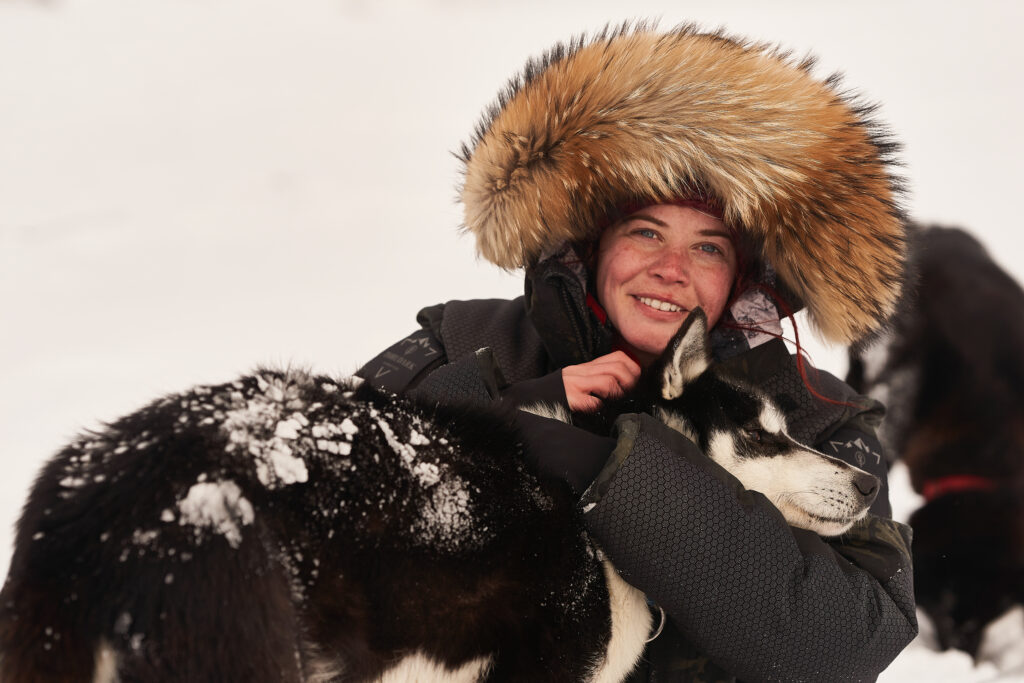The amazing dogs used form a significant part of Jukkasjärvi Wilderness Tours. The dogs live in packs and are handled with care and attention throughout their daily lives, from preparation to after a tour. But what do the routines actually look like for the dogs and how are they handled before, during and after our tours? The exact routines vary depending on the duration of a tour. In winter, most of the 140 adult dogs are always out on one of our tours, where the time span can vary from 3 hours to 42 days. To make it easier to give an overall picture, we will therefore use a day trip, from morning to evening, as an example.
Before the trip
Before a trip, it is the owners who make sure the dogs are ready for the start of a dog sledding trip. The owners have many years of experience with dogs, some of whom have worked for almost 20 years and have seen many dogs come and go. The dogs live in kennels all year round and they also have the opportunity to run free in a larger kennel. When the dogs are at home with their owners and not being used, they each have their own hut to sleep in, but most of the time the dogs sleep together in a hut or out in the snow. Once it's morning on a normal winter day, the dogs are given breakfast at seven in the morning. The food consists of dry food and mixed meats, which contain all the necessary vitamins as basic food for the dogs. Once breakfast is over, our employees prepare the different dog teams that will go out with the guests and their guides during the tour.

During the trip
Once the tour is underway, it is up to the guests themselves to look after their assigned dogs, under the supervision of the accompanying guide. The owners have a general briefing with the guests before departure on the tour on how the dogs should be handled, where they emphasize that they should be taken care of with care and attention in all situations. A dog team consists of four to five dogs and a sled where guests sit and "drive". Once on a tour, the dogs run at different speeds. During longer tours such as weekly tours over a whole week, the dogs run about 25-45 kilometers per day, where the distance depends a bit on the guests' ability and the weather. When it's time for lunch for the guests, the dogs also get a break and something to chew on in the form of fish snacks. Then the tour continues before the guests, the dogs and the guides return home again in the evening.
After the trip
When we return home, it is the owners who take back responsibility for the dogs. They make sure that the dogs are disconnected from the team and returned to their kennels and huts. Once back home, the dogs are given dinner usually around six in the evening, depending on what time we return from the tour. When a tour is finished, it's time for the dogs to rest, where they have about 18 hours of rest per day and after longer tours they have their day(s) off. All dogs are rotated with different types of jobs each week where everyone has their rest days. This depends on how much they run, eat, rest and any injuries, which are monitored in a database daily. Should a dog get injured during a run, the owners work closely with Lapplands Djurklinik, which ensures that any injured dog gets the best possible healing. Depending on the injury, the dog in question is set aside and allowed to rest for a period of time until it is fully recovered to be able to run in a dog sled again with its friends.

Sometimes, however, it is not because of an injury that a dog can no longer run, but because it has simply become too old. In order for the business to continue, the old dogs must of course be replaced, which is done continuously in the form of puppy breeding by the owners. Normally, there are two to three litters of puppies per year, depending on how many puppies the kennel gets in each litter. The puppies then start training to run in dog teams when they are around six to eight months old.
Summing up
The dogs Jukkasjärvi Vildmarksturer uses are central and their well-being is prioritized through careful routines by the owners. The dogs, which are mostly of the Siberian Husky breed and also some mixed breeds between Siberian and Alaskan Husky, are just as passionate as we are about giving our guests the best and most memorable experience possible. Whether before, during or after a tour, the health and physical status of the dogs always comes first. As a visitor and guest on one of our tours, you get a unique insight and closeness to the four-legged friends in an outstanding environment. Practically, you become the master or mistress of the dogs for the duration of the tour - a chance we highly recommend taking.

